|
|
|
Sort Order |
|
|
|
Items / Page
|
|
|
|
|
|
|
| Srl | Item |
| 1 |
ID:
123935
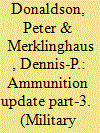

|
|
|
|
|
| Publication |
2013.
|
| Summary/Abstract |
The article reports on developments in large caliber gun ammunition with long range and precision guidance. BAE Systems, Oto Melara and Raytheon are some of the defense companies that have successfully tested systems that satisfy these requirements. ATK is another, being the manufacturer of large-caliber tank ammunition for the U.S. military. BAE has tested its Long-Range Land Attack Projectiles, while Israel Military Industries manufactures the 155mm Super-High-Explosive artillery projectile.
|
|
|
|
|
|
|
|
|
|
|
|
|
|
|
|
| 2 |
ID:
123399
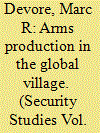

|
|
|
|
|
| Publication |
2013.
|
| Summary/Abstract |
Few issues are more important to international relations scholars than understanding how globalization is shaping the production of armaments. Within this context, this article examines both whether and how small and medium states can maintain defense-industrial bases capable of contributing to their national security. To preview the conclusion, although defense-industrial self-sufficiency has become an illusion for most states, even small and medium states can develop defense-industrial capabilities that enhance both their ability to autonomously employ their armed forces and secure access to foreign armaments. Moreover, governments possess a range of options for achieving these objectives, including a fundamental choice between accepting foreign direct investment and pursuing unrestrained arms exports. Governments unwilling to sanction foreign ownership of their defense industries can have recourse to unrestricted exports; alternatively, states uncomfortable with liberal exports can encourage foreign direct investment. With this in mind, a lasting diversity is likely to persist in even similarly endowed states' defense industries and defense-industrial policies.
|
|
|
|
|
|
|
|
|
|
|
|
|
|
|
|
| 3 |
ID:
072377
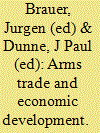

|
|
|
|
|
| Publication |
London, Routledge, 2004.
|
| Description |
xiv, 326p.Hardbound
|
| Standard Number |
0415331064
|
|
|
|
|
|
|
|
|
|
|
|
Copies: C:1/I:0,R:0,Q:0
Circulation
| Accession# | Call# | Current Location | Status | Policy | Location |
| 051329 | 382.456234/BRA 051329 | Main | On Shelf | General | |
|
|
|
|
| 4 |
ID:
130131
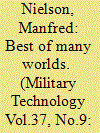

|
|
|
|
|
| Publication |
2013.
|
| Summary/Abstract |
The article offers information related to the Joint Support Service (JSS), military organisational area of the Bundeswehr, the unified armed forces of the Federal Republic of Germany and their civil administration and procurement authorities, and firmly established with its partners from trade and industry.
|
|
|
|
|
|
|
|
|
|
|
|
|
|
|
|
| 5 |
ID:
142976
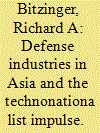

|
|
|
|
|
| Summary/Abstract |
Asia is a region of growing militarization and insecurity. It is increasingly characterized by rising defense expenditures and rapidly modernizing militaries, and subsequently it is increasingly becoming a zone of potential conflict. These security concerns are exacerbated by Asian countries’ expanding capacities for indigenous armaments production. Asian arms production is heavily influenced by concepts of techno-nationalism, which views autarky (self-sufficiency in armaments) as serving not only national defense needs, but also as maximizing national political, strategic, and economic autonomy. The technonationalist model is more than a set of goals; it also embodies a strategy for achieving autarky in armaments production, including the short-term exploitation of foreign-sourced technologies. What is the most interesting about Asian arms industries is how enduring they have been despite the fact that they produce few economic benefits and contribute so little to guaranteeing security of supply or expanding military-technological capacities for national defense. Asian armaments production has rarely been cost-effective or militarily significant in terms of turning out state-of-the-art military equipment. And yet, most large powers in Asia have not abandoned the idea of autarky in armaments production, often with explicit technonationalist industrial strategies. Despite problems with this technological-industrial approach, it is unlikely that these countries will abandon techno-nationalism anytime soon.
|
|
|
|
|
|
|
|
|
|
|
|
|
|
|
|
| 6 |
ID:
038470


|
|
|
|
|
| Publication |
Colorado, Westviwe Press, 1989.
|
| Description |
xii, 278p
|
| Series |
Pacific and world studies; no.3
|
| Standard Number |
0813305861
|
|
|
|
|
|
|
|
|
|
|
|
Copies: C:1/I:0,R:0,Q:0
Circulation
| Accession# | Call# | Current Location | Status | Policy | Location |
| 031397 | 355.621/BAE 031397 | Main | On Shelf | General | |
|
|
|
|
| 7 |
ID:
043811


|
|
|
|
|
| Publication |
London, Faber and Faber, 1975.
|
| Description |
251p.
|
| Standard Number |
0571107400
|
|
|
|
|
|
|
|
|
|
|
|
Copies: C:1/I:0,R:0,Q:0
Circulation
| Accession# | Call# | Current Location | Status | Policy | Location |
| 015356 | 355.622/KEN 015356 | Main | On Shelf | General | |
|
|
|
|
| 8 |
ID:
125992


|
|
|
|
|
| Publication |
2013.
|
| Summary/Abstract |
Chairman, Saab India Technologies Pvt. Ltd, Lars-Olof Lindgren's first year in the new job has been exciting albeit a bit slow. But an old India hand (he was Swedish ambassador to India for five years from 2007-2012), Lindgren understands that in India lack of speed is not such a bad thing. On the contrary, it may even be a good thing as it gives time for repeated confabulations and, who know, reconsiderations
|
|
|
|
|
|
|
|
|
|
|
|
|
|
|
|
| 9 |
ID:
123940
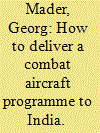

|
|
|
|
|
| Publication |
2013.
|
| Summary/Abstract |
The article discusses factors that should be considered when delivering a combat aircraft system to India. According to the author, defense companies should have the patience and financial strength because many undertakings are likely to miss their projected in-service dates. He claims that the slow progress is due to Indian officials having bad past experiences with partner companies, both domestic and foreign. He adds that the constantly changing domestic politics should also be considered.
|
|
|
|
|
|
|
|
|
|
|
|
|
|
|
|
| 10 |
ID:
054453
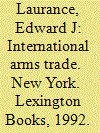

|
|
|
|
|
| Publication |
New York, Lexington Books, 1992.
|
| Description |
xvii, 245p.Hardbound
|
| Standard Number |
0669199281
|
|
|
|
|
|
|
|
|
|
|
|
Copies: C:1/I:0,R:0,Q:0
Circulation
| Accession# | Call# | Current Location | Status | Policy | Location |
| 034042 | 382.456234/LAU 034042 | Main | On Shelf | General | |
|
|
|
|
| 11 |
ID:
125341


|
|
|
|
|
| Publication |
2013.
|
| Summary/Abstract |
Grenade launching and their ammunition are currently experiencing the fastest and most dramatic period of development of any small arms. In NATO armies, the traditional 40x46 mm low velocity (LV) and 40x53 mm high velocity (HV) rounds used in shoulder fired and crew-served launchers respectively still dominate, although ammunition offered for shoulder fired weapons now includes LV extended range LV-ER and medium velocity - MU to provide greater reach.
|
|
|
|
|
|
|
|
|
|
|
|
|
|
|
|
| 12 |
ID:
026035


|
|
|
|
|
| Edition |
vol. II
|
| Publication |
London, Sage Publications, 1972.
|
| Description |
xii, 340p.
|
| Standard Number |
0803901348
|
|
|
|
|
|
|
|
|
|
|
|
Copies: C:1/I:0,R:0,Q:0
Circulation
| Accession# | Call# | Current Location | Status | Policy | Location |
| 012926 | 355.0213/SAR 012926 | Main | On Shelf | General | |
|
|
|
|
| 13 |
ID:
182632


|
|
|
|
|
| Summary/Abstract |
Both Israel and Singapore engage in military-technological innovation in areas deemed critical to strategic sovereignty. Both countries have consistently championed high levels of funding for military R&D and for maintaining and nurturing indigenous defense industries. Both countries have, to a varying degree, also strongly supported the cultivation of local S&T, including the spin-on of commercial high-technology breakthroughs into the defense sector. Israel has been more successful when it comes to military-technological innovation, mostly because it has to: its strategic situation is much more tenuous than Singapore’s. Singapore, on the other hand, faces much less of an existential threat, and so its military-technological innovation activities are more one of desire than necessity.
|
|
|
|
|
|
|
|
|
|
|
|
|
|
|
|
| 14 |
ID:
120253
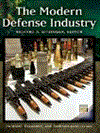

|
|
|
|
|
| Publication |
California, Praeger Security International, 2009.
|
| Description |
xi,375p.hbk
|
| Standard Number |
9780275994754
|
|
|
|
|
|
|
|
|
|
|
|
Copies: C:1/I:1,R:0,Q:0
Circulation
| Accession# | Call# | Current Location | Status | Policy | Location | IssuedTo | DueOn |
| 057278 | 338.47355/BIT 057278 | Main | Issued | General | | RF091 | 17-Jan-2024 |
|
|
|
|
| 15 |
ID:
126434
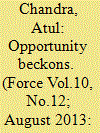

|
|
|
|
|
| Publication |
2012.
|
| Summary/Abstract |
One would be hard pressed to find any aircraft manufacturer, anywhere in the world today, which has on its plate such a vast range of aeronautical programmes as Hindustan Aeronautics Limited (HAL) does today. At a time when the defence budgets have been sliced to shreds in most countries, HAL rests in the enviable position of having aircraft programmes across the board. The Indian Air Force (IAF) expects to spend in excess of USD 35 billion by 2022 (when the 13th plan ends) on new acquisitions and its existing commitments. HAL will have to manage and deliver the indigenous design, development and manufacture of fixed wing (Tejas and Sitara) and rotary wing (Dhruv, Light Combat Helicopter, Light Utility Helicopter) platforms, along with Russian collaboration for the 5th generation PMF (Sukhoi T-50) and Medium Transport Aircraft (MTA).
|
|
|
|
|
|
|
|
|
|
|
|
|
|
|
|
| 16 |
ID:
051307
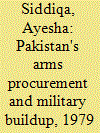

|
|
|
|
|
| Publication |
Hampshire, Palgrave, 2001.
|
| Description |
xvi, 230p.
|
| Standard Number |
0333731727
|
|
|
|
|
|
|
|
|
|
|
|
Copies: C:1/I:0,R:0,Q:0
Circulation
| Accession# | Call# | Current Location | Status | Policy | Location |
| 044286 | 355.8095491/SID 044286 | Main | On Shelf | General | |
|
|
|
|
| 17 |
ID:
095042


|
|
|
|
|
| Publication |
2010.
|
| Summary/Abstract |
The global defense-industrial sector reflects the hierarchy of power in the post-Cold War world. As in the larger international system, the United States plays the dominant role in the defense sector as well. It is a comparative advantage often used by US policymakers to influence the foreign policy behavior of other states. Curiously, the radical concentration of the world's defense industrial sector, as described here, has received relatively little scrutiny from either academia or the media, even though it not only reflects the international order but provides the United States with considerable leverage in it.
|
|
|
|
|
|
|
|
|
|
|
|
|
|
|
|
| 18 |
ID:
143684


|
|
|
|
|
| Summary/Abstract |
Few factors have a greater impact on the international distribution of power than states’ ability to develop and produce sophisticated weaponry. The Israeli and Swedish cases demonstrate the constraints and opportunities for small states’ defense-industrial bases in a globalizing world. The changing nature of arms production—including mounting weapons costs, globalized supply chains and the rise of multinational defense corporations—forced governments to reevaluate their defense-industrial policies. In each case, governments abandoned the pursuit of defense-industrial self-sufficiency and adopted export-dependent defenseindustrial policies. National strategies differ, however, with Sweden embracing foreign direct investment (FDI) to support incremental innovation and Israel encouraging companies to tap venture capital in pursuit of disruptive innovations. After a decade of sustained growth, the Israeli and Swedish defense-industrial bases today arguably suffer from structural weaknesses rooted in the adaptation policies each state adopted in prior decades and, more particularly, how each encouraged exports and drew on new forms of investment capital.
|
|
|
|
|
|
|
|
|
|
|
|
|
|
|
|
| 19 |
ID:
122967


|
|
|
|
|
| Publication |
2012.
|
| Summary/Abstract |
The article presents information on innovations in military rocket systems, which have a long history as multirole artillery weapons. Some of the initiatives include high-mobility and distributed artillery rocket applications like the U.S. Army tactical systems in use by Regimental Combat Teams. It is also stated that revolutions in military affairs have transformed the baseline platform technology of the Multiple Launch Rocket Systems (MLRS) to support modern operations.
|
|
|
|
|
|
|
|
|
|
|
|
|
|
|
|
| 20 |
ID:
120255


|
|
|
|
|
| Publication |
New York, Farrar, Straus and Giroux, 2011.
|
| Description |
xxx,672p.hbk
|
| Standard Number |
9780374208387
|
|
|
|
|
|
|
|
|
|
|
|
Copies: C:1/I:0,R:0,Q:0
Circulation
| Accession# | Call# | Current Location | Status | Policy | Location |
| 057280 | 382.456234/FEI 057280 | Main | On Shelf | General | |
|
|
|
|
|
|
|
|
|